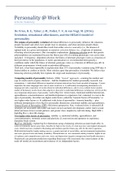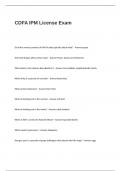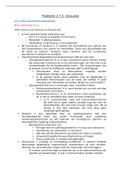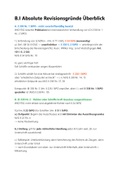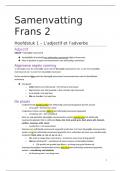Personality @ Work
Articles Summary
De Vries, R. E., Tybur, J. M., Pollet, T. V., & van Vugt, M. (2016).
Evolution, situational affordances, and the HEXACO model of
personality
The enigma of personality variation Individual differences in personality influence the situations
people encounter and select, how people react to situations, and what outcomes people obtain.
Variability in personality should thus result from either selective neutrality (i.e., the absence of
optimal traits in a given environment) or mutation–selection balance (i.e., a high rate of mutation,
offsetting selection pressures). But: incomplete explanations. Balancing selection posits that genetic
polymorphisms are maintained because the fitness pay-offs of resulting phenotypes vary across time
and place: 1) frequency- dependent selection: the fitness of alternate genotypes varies as a function of
their prevalence in the population, 2) niche specialization (or: environmental heterogeneity):
conditions under which the fitness of alternate genotypes varies as a function of different pay-offs in
different environments → both result in individual differences.
Until now, it has been impossible to explain more than 21% of personality variation using SNP data →
limited ability to confirm or falsify. Most scholars agree that personality is heritable. We believe that
balancing selection probably best explains the origin and maintenance of personality.
Competing models of personality Galton's (1884) “lexical” approach—counting the number and
type of words used to express character—laid the foundation for modern personality research; four
assumptions: 1) individual differences important in human interactions have been encoded in language, 2) more
important, the more languages have one or more words for it, 3) sufficiently encompassing dictionaries of a
language provide a repository of words related to individual differences, and 4) cross-cultural factor analytic
studies of dictionary words (most often adjectives) that refer to individual differences in behaviors will reveal the
most important dimensions of personality. Led to Big five: extraversion, emotional stability/neuroticism,
agreeableness, conscientiousness, and intellect/openness to experience, but: contested → a) not at the
apex of personality, but either one higher-order factor, called the ‘General Factor of Personality’ or
two higher-order factors vs. b) additional sixth factor of personality—honesty-humility— plus
different interpretation of two big five personality dimensions: emotional stability and agreeableness.
General Factor of Personality (GFP): life history perspective; Fast, r-selected (slow, k-selected) LH
strategies are associated with earlier and faster (slower and later) development, earlier (later) sexual
debut and more (fewer) sexual partners, and greater (less) impulsivity and risk taking. High GFK >
high Big Five > slow LK strategy.
Two higher-order factors of personality: stability: α, emotional stability, agreeableness, and
conscientiousness; serotonin system and plasticity: β, extraversion and openness to experience,
dopamine brain system.
Big Five (OCEAN): explain big five dimensions using a balancing selection account (trade-offs): In
some environments and at some times, benefits for high or low levels of a trait may have outweighed subsequent
costs, which may have resulted in fluctuating and situation-specific fitness pay-offs for the trait in question.
Extraversion benefits: higher mating success, a greater network of social allies, and environmental exploration,
and costs: physical risks and family instability. Neuroticism (or: low emotional stabiliy) benefits: higher levels
of vigilance and competitiveness and costs: stress and depression (negative interpersonal and health outcomes).
Framework can generate predictions regarding fitness pay-offs associated, but: some features of the
trade-off model are inconsistent and existence of six independent factors.
, 2
HEXACO: based on the same lexical data that have uncovered the big five. Extraversion (X),
conscientiousness (C), and openness to experience (O), correspond well to the similarly named big
five. The sixth dimension—honesty–humility (H)—is the most important distinction and defined by
traits pertaining to sincerity, fairness, greed avoidance, and modesty versus deceitfulness, slyness,
greediness, and pretentiousness—traits that are largely absent from the big five. Agreeableness (A)
and emotionality (E) partially—but incompletely—overlap with big five agreeableness and emotional
stability: both: anxiety, fearfulness, and dependence. But HEXACO E does not contain ‘hostility’
component, low B5 E is low A in HEXACO plus, ‘sentimentality’ is A in B5 but E in HEXACO.
→ high emotionality (H) = low emotional stability (e.g. anxiety) + high agreeableness (e.g. sentimentality)
→ high agreeableness (H) = high agreeableness (B5, e.g. gentleness) + high emotional stability (e.g. patience)
Compared to the big five model, the HEXACO model (1) has offered a better description of the largest
set of replicable factors that have emerged in comparative cross-cultural lexical research, and (2) has
been found to better predict a number of important criteria, including counterproductive, delinquent,
and outright criminal behaviors, sexual exploitative behaviors, and prosocial behaviors such as
cooperation.
Domain-specific situational affordances (DSSA) Different situations have distinct situational
affordances that allow different aspects of personality to be expressed (or “activated”), which, in turn,
result in different benefits and costs.
Situation, trait, and outcome activation (STOA) Three mechanisms: 1) a situation activation mechanism, 2)
a trait activation mechanism, and 3) an outcome activation mechanism; entails that personality shapes
situations, i.e., that people are likely to consciously or unconsciously perceive, select, evoke, and/or
manipulate situations to fit their personality. May have been important driver for both situational and
trait diversity. Trait activation mechanism → trait activation theory (TAT): situations are characterized
by cues to affordances; people are more likely to select situations in which they can activate their traits and, in
these situations that activate their traits, people are more likely to behave in accordance to their given trait level ;
situational affordances not only allow (or restrict) trait activation, but also determine – when activated
– trait outcomes, explaining why bidirectional effects of personality are found; situations may vary in the
extent to which they offer positive, negative, or no effects, depending on the distribution of traits of others in that
situation.
DIAMONDS: the eight situational affordances dimensions: 1) a task to be done (duty, C), 2) to engage
intellectually (intellect, O), 3) contain conflict (adversity, reversed A), 4) romantically or sexually
charged (mating, potentially X), 5) to be pleasant (positivity, reversed E, potentially X), 6) to be
unpleasant (negativity, E), 7) opportunity to deceive someone (deception, H-H), and 8) to entail social
interaction (sociality, X).
, 3
HEXACO domain-specific effects
H Trait activation of honesty–humility, in turn, is more likely in situations that allow for exploitation.
People low on H-H are more likely
1) to seek out situations that offer easy access to casual sex, money, and status (brothels, criminal
neighborhoods, political movements, highly volatile businesses )
2) to behave in manipulative, unfair, self-enhancing, or exploitative manners in these situations
3) low H-H offers material and status benefits or costs, depending on the strength of countervailing situational
forces
E Situation activation of insecurity is thus more likely for people low on emotionality; is the most sex-
differentiated personality trait (women 1 SD higher) related to outcome activation: Seeking help may
be more beneficial (reproductive advantages) to women than to men, because help-seeking may result
in lower levels of social status for men rather than for women.
1) people low on emotionality are more likely to seek activities that involve physical or material risks
2) people high on emotionality are more likely to react with fear, anxiety, worry, and dependence in insecure
situations
3) emotionality has a positive or negative effect on outcomes, depending on gender, actual risks, and visibility
of behaviors involved
X The core of extraversion is social attention, extraverted individuals are more likely to participate in
social interactions → situation activation of sociality is more likely for people high in extraversion. X
is the most visible personality trait.
1) extraverts are more likely to seek out social situations and positions
2) extraverts are more likely to react to social situations with enthusiasm, liveliness, and social boldness
3) extraversion has positive or negative consequences depending on network size and social scrutiny
, 4
A Important distinction between H and A is that agreeableness is associated with acceptance of unfair
offers in ultimatum games, showing that A has to do with reactive - instead of proactive - prosocial
cooperative attitudes.
1. disagreeable people more often get into (relational) conflicts, physical and verbal fights, and are more likely
to have relational break-ups
2. an individual's level of agreeableness is most noticeable in offensive, provoking, or outright conflictual
situations
3. disagreeable or outright aggressive reactions may be beneficial or costly, depending on the power and
interdependencies of the parties involved
C Highly conscientious people are more likely to seek out situations that require ordering and/or goal-
oriented behaviors, C seems to be related to a better work-family balance (better planning of duties),
most notable when tasks need to be performed. Relation between C and both study and work
performance is among the strongest and most reliable effects in personality psychology. But: task
engagement is costly in energy (perfectionism not needed in low complexity tasks), hard to adapt to
changing circumstances, low C may result in social loafing benefits and are better able to withdraw
from situations that do not benefit them.
(1) conscientious people are more likely to organize and transform their environments to fit their need for
control and achievement
(2) in situations that require goal- or task-oriented behaviors, conscientiousness is associated with differences in
actual planning, organizing, performing, and detail-oriented behaviors making observers more likely to
accurately perceive somebody's level of conscientiousness
(3) conscientiousness will have positive or negative effects on outcomes, depending on the conversion ratio of
task energy expenditure
O Openness to experience is positively related to situation activation of exploration; most strongly
related to positive training outcomes; high O beneficial when resources are scarce and environment
unstable.
(1) people high on O are more likely to visit unknown places, take an interest in intellectual matters, try out new
foods and ideas, show more interest in unusual people, and get involved in artistic activities
(2) openness to experience is more likely to be activated and observed when an individual is exposed to novel
ideas and places
(3) behaviors associated with openness to experience, such as curiosity, trying out new things, and exploring new
territories, can be costly when the environment is dangerous and when there is not much tolerance for new ideas,
but it can yield high pay-offs
Testing hypotheses
1. Situation activation: comparing the personality that have activated or ‘selected’ a particular situation with
the personality of a comparable control group. Linked with niche specialization (X and O).
2. Trait activation: designs in which people experience a number of situations that afford activation of one of
the traits.
3. Outcome activation: measuring benefits and costs of high versus low levels of traits in situations
characterized by the six dimensions provided here. Linked with frequency-dependent selection (H).

